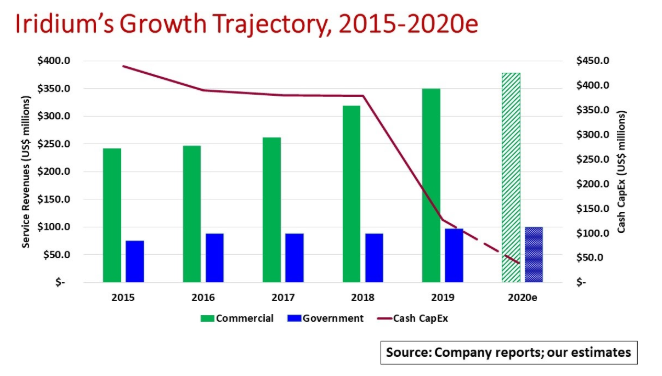Iridium Communications (NasdaqGS: IRDM) is unique among mobile satellite services providers. The company operates a constellation of 66 satellites in low earth orbit (LEO) that provides continuous mobile voice and data connections for end users across the entire globe.
Iridium’s LEO satellites orbit the earth every 100 minutes at distances between 300 and 1,000 miles. Compared to other types of satellite services, LEO has lower latency on connections between a satellite and user equipment on the earth’s surface.
Iridium’s network operates in the L-band at 1.6 GHz and is designed with an interlinked mesh architecture to route traffic across its constellation using RF crosslinks between satellites. The company claims that this unique architecture minimizes the need for related ground infrastructure to support the constellation. In turn, this architecture allows Iridium to offer services in countries and regions where it has no physical presence.
Understand that data communications over satellite is narrowband, measured in Kbps. In February 2019, the company completed its Iridium NEXT® next-generation satellite program, replacing the company’s first-generation satellites that were in service for nearly 20 years. The new NEXT constellation maintains the same interlinked mesh architecture as the first-generation constellation and is compatible with all end-user equipment.
The NEXT constellation supports higher data speeds. Iridium’s CERTUS® broadband service will provide users with broadband connections up to 1.4 Mbps.
Starting in 2010, Iridium invested approximately $3 billion for design, build and launch of the NEXT program. With the new satellite constellation and associated ground facilities in place and operational, the company now expects to enjoy a “10-year capex holiday” from the massive amounts invested every year while building the NEXT network. Nonetheless. Iridium’s maintenance capex will run about $35 million a year over the coming decade.
Service revenues reached $447 million in 2019 having grown at a 7-8 percent CAGR since 2009. Iridium expects 2020 services revenues will grow at the same rate even with some anticipated coronavirus-related customer slowdowns.
Iridium provides voice and data communications services to commercial businesses, the U.S. and foreign governments, non-governmental organizations and consumers. Its satellite network reaches regions of the world where terrestrial wireless or wireline networks do not exist or are limited. These regions include remote land areas, open ocean, airways, the polar regions and regions where the telecommunications infrastructure has been affected by political conflicts or natural disasters.
Commercial customers are in land/mobile, maritime and aviation segments along with Internet of Things (IoT) applications. The common thread is that all these customers need voice and data services, asset tracking and telematics reporting in areas not served by terrestrial networks. Iridium sees substantial growth in IoT for monitoring equipment in remote industrial applications such as oil and gas, and mining.
The company points out that many of its end users view its satellite services as critical to their daily operations and integral to their communications and business infrastructure. As an example, multinational corporations in various sectors rely on Iridium services for business telephony, e-mail and data transfer including telematics, and mobile communications services for employees who work in these remote operations.
Government organizations including military and intelligence agencies, disaster responders, non-governmental organizations and support teams rely on Iridium’s mobile and fixed voice and data satellite communications services to keep them connected.
Iridium recently committed to a multi-year, fixed-price contract with the U.S. government to provide specified satellite airtime services for an unlimited number of U.S. DoD and other federal government agencies. This contract has a total value of $738.5 million over its seven-year term that ends in 2026.
By John Celentano, Inside Towers Business Editor





Reader Interactions